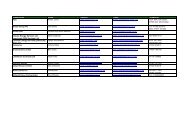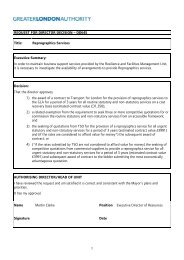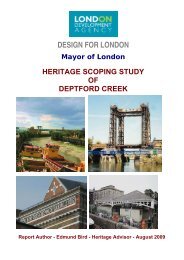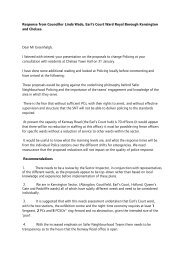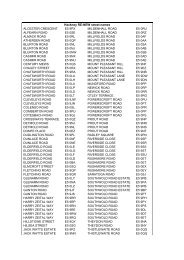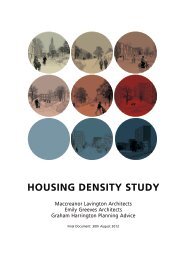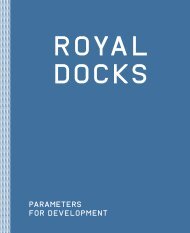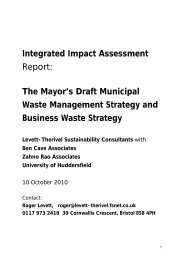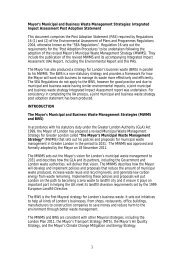AF01 Lee Valley and Finchley Ridge.pdf - Greater London Authority
AF01 Lee Valley and Finchley Ridge.pdf - Greater London Authority
AF01 Lee Valley and Finchley Ridge.pdf - Greater London Authority
Create successful ePaper yourself
Turn your PDF publications into a flip-book with our unique Google optimized e-Paper software.
Forward Strategy – Recommendations<br />
It is now some five years since the original area<br />
framework was produced. Independent evaluation of<br />
the earlier East <strong>London</strong> Green Grid programme has<br />
confirmed its role in enabling the various partners<br />
<strong>and</strong> stakeholders to work collectively, to assist in<br />
securing funds, <strong>and</strong> encourage organisations to think<br />
about how their activities contribute to the collective<br />
benefits across the wider area.<br />
The rationale for this update was to:<br />
- review progress, recognise successes to date<br />
<strong>and</strong> identify reasons for any projects that have<br />
progressed more slowly than intended<br />
- exp<strong>and</strong> area to the west to take in <strong>Finchley</strong> <strong>Ridge</strong><br />
<strong>and</strong> the catchments of the tributary streams to the<br />
<strong>Lee</strong><br />
- refresh the existing area analysis, project<br />
programme <strong>and</strong> delivery strategy in light of current -<br />
economic operating environment<br />
- increase the range of partners to deliver the<br />
programme, fund it <strong>and</strong> champion it to support future<br />
sustainability<br />
- use the refresh process to engage with strategic<br />
private sector partners such as the utility companies<br />
<strong>and</strong> selected developers etc to steer their future<br />
investments to increase GI delivery<br />
- ensure close alignment with GLA key programmes<br />
such as the Mayor’s Low Carbon agenda plus existing<br />
housing development <strong>and</strong> regeneration priorities<br />
- continue to embed the GG into local planning policy<br />
to maximise sustainability<br />
- support future exit strategies for the Green Grid to<br />
reflect the current Localism <strong>and</strong> Big Society agendas<br />
- take on board additional objectives which offer<br />
the capability to support economic development,<br />
such as increasing the value of the visitor economy,<br />
developing social enterprise models to deliver green<br />
space management <strong>and</strong> maintenance, support the<br />
green skills agenda <strong>and</strong> enable strategic productive<br />
l<strong>and</strong>scape projects<br />
- support the assimilation of the ELGG programme<br />
into the All <strong>London</strong> Green Grid<br />
Governance<br />
One of the defining features of the Lea <strong>Valley</strong> Green<br />
Grid sub area is the complexity <strong>and</strong> diversity of<br />
l<strong>and</strong>owners, managers <strong>and</strong> stakeholders, covering<br />
a large geographical area. While this area framework<br />
has been prepared with input from this range of<br />
organisations, it has become increasingly evident<br />
in the five years since the first area framework was<br />
produced that a single partnership steering group is<br />
unlikely to be the optimum governance structure.<br />
As an alternative, it is proposed that governance<br />
of the Green Grid initiative should, where possible,<br />
become the responsibility of existing partnership<br />
groups, which cover smaller geographical areas<br />
within the Lea <strong>Valley</strong> sub area. In some areas these<br />
partnerships groups are reasonably well established.<br />
In other areas, existing <strong>and</strong> proposed organisational<br />
structures will be required to take the lead in the<br />
Green Grid initiative, while in others still, a new<br />
partnership structure may well be required.<br />
The role of these groups is to:<br />
- ensure the outcomes from the area framework<br />
refresh are locally embedded <strong>and</strong> endorsed<br />
-enable groups to be exp<strong>and</strong>ed/consolidated where<br />
required to take on board partners in the new areas<br />
<strong>and</strong> maximise future sustainability<br />
- encourage the project programme to be<br />
underpinned by robust local funding strategies<br />
-maximise partnership processes to assist in delivery<br />
In order to resolve the above issues, we propose to<br />
investigate in greater detail with key partners the<br />
governance proposal below.<br />
In the Lower Lea, the <strong>London</strong> Thames Gateway<br />
Development Corporation <strong>and</strong> the Olympic Delivery<br />
<strong>Authority</strong> are in their final operating phases although<br />
their work is likely to be progressed by new entities<br />
such as the Mayoral Development Corporation <strong>and</strong><br />
the Olympic Park Legacy Company. It seems likely<br />
that the latter organisation would be well suited to<br />
provide direction <strong>and</strong> momentum to a number of<br />
the projects within the framework, <strong>and</strong> to lead a<br />
partnership approach to delivering the wider Green<br />
Grid programme in the Lower Lea.<br />
In the Upper Lea the concept of the Walthamstow<br />
Wetl<strong>and</strong>s has firmly taken root bringing a number<br />
of stakeholders together to deliver an exciting <strong>and</strong><br />
diverse portfolio of projects. It is a natural extension<br />
of that initiative to incorporate the Green Grid<br />
programme for that area.<br />
In the <strong>Finchley</strong> <strong>Ridge</strong> area, it seems probable that a<br />
new partnership group will be required, particularly<br />
as this area has a different mix of stakeholder<br />
organisations than the Lea <strong>Valley</strong>.<br />
All partners however share the aspiration to deliver<br />
an open space network that will fully meet needs<br />
of both the neighbouring local communities, whilst<br />
at the same time developing destinations that are<br />
attractive to local, regional, national <strong>and</strong> international<br />
visitors.<br />
Programme Overview<br />
In the short term (next 1-2 years) in the Lea <strong>Valley</strong><br />
we propose to continue to provide a number of ‘quick<br />
wins’ that will deliver projects to improve connections<br />
into <strong>and</strong> across the <strong>Valley</strong> <strong>and</strong> to enhance the quality<br />
<strong>and</strong> offer of the existing open spaces. These short<br />
term ambitions continue the earlier framework<br />
priorities to improve access, routes <strong>and</strong> overcome<br />
barriers to allow people to get to <strong>and</strong> through the<br />
existing open space resource: helping to better<br />
connect the neighbouring communities to the open<br />
space network <strong>and</strong> encourage use <strong>and</strong> a sense of<br />
ownership amongst local residents.<br />
These short term ambitions are exemplified by<br />
completed or ongoing projects such as Fatwalk, the<br />
Olympic walking <strong>and</strong> cycling routes work. Existing<br />
open space enhancements at Three Mills Green,<br />
Hackney Marsh <strong>and</strong> Tottenham Marshes will be<br />
followed by similar enhancement projects on other<br />
open space areas.<br />
There will be a focus on taking forward a number<br />
of earlier ELGG supported projects to fruition<br />
particularly those that work to maximise the<br />
l<strong>and</strong>scape quality <strong>and</strong> visibility of key spaces, <strong>and</strong><br />
their potential to operate as visitor destinations.<br />
This will include work to transform the accessibility<br />
of existing areas of operational utility space - such<br />
as the Walthamstow Reservoirs - <strong>and</strong> exploring the<br />
potential to transform them, where appropriate, into<br />
genuine visitor destinations.<br />
In the <strong>Finchley</strong> <strong>Ridge</strong> area we will focus on further<br />
development <strong>and</strong> feasibility assessment of the major<br />
open spaces such as Trent Country Park.<br />
In the medium term (2-5 years) there will be a focus<br />
of further developing the Queen Elizabeth Olympic<br />
Park, establishing new open space areas as part<br />
of Lea River Park, <strong>and</strong> open space improvements<br />
as component parts of major regeneration projects<br />
(e.g. Meridian Water, Ponders End) alongside<br />
Walthamstow Wetl<strong>and</strong>s, <strong>and</strong> <strong>Finchley</strong> <strong>Ridge</strong>.<br />
Thredding through these ambitions will be a desire<br />
to improve the local park networks across the area<br />
but with a focus on those within the <strong>Finchley</strong> <strong>Ridge</strong><br />
to ensure they have good facilities <strong>and</strong> connections<br />
to the surrounding urban fabric, as well as links to the<br />
major open spaces of the Lea <strong>Valley</strong>.<br />
In the longer term (5-10 yrs) there are desires to<br />
link successfully with other key open spaces such<br />
as those within Epping Forest <strong>and</strong> the proposed<br />
metropolitan park in the Roding <strong>Valley</strong>. The Green<br />
Grid has always sought to maximise the capacity<br />
for spaces to become better connected <strong>and</strong> this<br />
51



